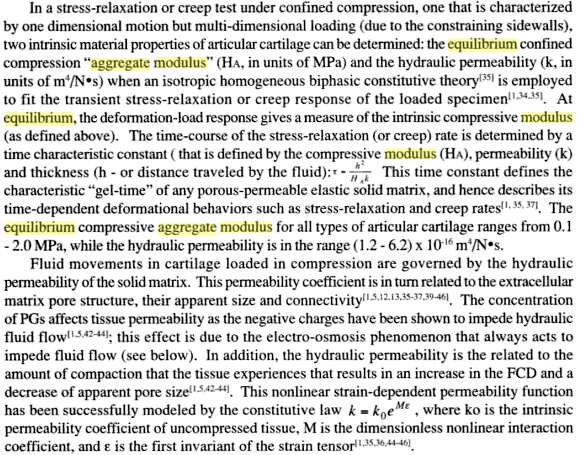Me: This article talks about what was seen when you take two of the most common growth factors TGF-Beta1 and IGF-1 and use them in conjunction with dynamic deformational loading application on hydrogels which are embedded with chondrocytes. Like with a recent post where three patents were analyzed with the idea that you take the chondrocyte in gel form and get that implanted into articular cartilage knee defects and use them to fill up the cartilage this mixture can be used instead of just growth factors. The application of dynamic deformational loading has already been shown to get chondrocyte implanted into hydrogels to cause expansion in volume size.
Note that in normal epiphyseal growth plate cartilage, there is two main components in the cartilage matrix.
- Proteoglycan – (these two parameters or variable increase with using either growth factor or loading but increased more with them combined)
- Collagen Type II
 We also have something called the equilibrium aggregate modulus. From research and other sources (HERE) it is a term that is calculated taking into account values for thickness, permeability, and the compressive modulus. The equilibirum aggregate modulus is really sort of a way to measure the strength, durability, and viscosity of a cartilage element (or something like that. Not completely sure right now).
We also have something called the equilibrium aggregate modulus. From research and other sources (HERE) it is a term that is calculated taking into account values for thickness, permeability, and the compressive modulus. The equilibirum aggregate modulus is really sort of a way to measure the strength, durability, and viscosity of a cartilage element (or something like that. Not completely sure right now).Implications for height increase: The researchers said at the end that..“These results support the hypothesis that the combination of chemical and mechanical promoters of matrix biosynthesis can optimize the growth of tissue-engineered cartilage constructs.” What this means that when we do get the LSJL device built, it would be smart to combine it with also growth factors TGF-Beta1 and IGF-1 for maximum effect. To do this for a height increase application, we could just take thick needles and make injections of the two growth factors directly into the long bone epiphysis and then get the LSJL device to dynamically load the epiphysis treating the epiphysis as the hydrogel with chondrocytes encapsulated. We have already proven that lateral dynamic loading on the bone will cause the MSCS inside to differentiate into chondrocytes. Maybe just these two parts is enough but if it is not as effective as hoped, we can add the initial step of injecting hydrogels embedded with chondrocytes first into the epiphysis to begin with through the side, then add the growth factors, and then the loading using the LSJL device. These would allow an initial seed of chondrocytes aggregate to start with and any chondrocyte that results from the growth factor injections or LSJL device loading will layer on top and aggregate with the initial seed after the hydrogel dissolves.
From Link HERE… (Full article on links below)
Synergistic Action of Growth Factors and Dynamic Loading for Articular Cartilage Tissue Engineering
To cite this article:
Robert L. Mauck, Steven B. Nicoll, Sara L. Seyhan, Gerard A. Ateshian, and Clark T. Hung. Tissue Engineering. August 2003, 9(4): 597-611. doi:10.1089/107632703768247304.
Published in Volume: 9 Issue 4: July 9, 2004
- Full Text PDF (5,102.3 KB), Full Text PDF with Links (4,358 KB)
Author information
Robert L. Mauck, MS – Department of Biomedical Engineering, Columbia University, New York, New York.
Steven B. Nicoll, PhD – Department of Biomedical Engineering, Columbia University, New York, New York.
Sara L. Seyhan, BS – Department of Biomedical Engineering, Columbia University, New York, New York.
Gerard A. Ateshian, PhD – Department of Biomedical Engineering, Columbia University, New York, New York.
Clark T. Hung, PhD – Department of Biomedical Engineering, Columbia University, New York, New York.
It has previously been demonstrated that dynamic deformational loading of chondrocyte-seeded agarose hydrogels over the course of 1 month can increase construct mechanical and biochemical properties relative to free-swelling controls. The present study examines the manner in which two mediators of matrix biosynthesis, the growth factors TGF-β1 and IGF-I, interact with applied dynamic deformational loading. Under free-swelling conditions in control medium (C), the [proteoglycan content][collagen content][equilibrium aggregate modulus] of cell-laden (10 × 106 cells/mL) 2% agarose constructs reached a peak of [0.54% wet weight (ww)][0.16% ww][13.4 kPa]c, whereas the addition of TGF-β1 or IGF-I to the control medium led to significantly higher peaks of [1.18% ww][0.97% ww][23.6 kPa]C-TGF and [1.00% ww][0.63% ww][19.3 kPa]C-IGF, respectively, by day 28 or 35 (p < 0.01). Under dynamic loading in control medium (L), the measured parameters were [1.10% ww][0.52% ww][24.5 kPa]L, and with the addition of TGF-β1 or IGF-I to the control medium these further increased to [1.49% ww][1.07% ww][50.5 kPa]L-TGF and [1.48% ww][0.81% ww][46.2 kPa]L-IGF, respectively (p < 0.05). Immunohistochemical staining revealed that type II collagen accumulated primarily in the pericellular area under free-swelling conditions, but spanned the entire tissue in dynamically loaded constructs. Applied in concert, dynamic deformational loading and TGF-β1 or IGF-I increased the aggregate modulus of engineered constructs by 277 or 245%, respectively, an increase greater than the sum of either stimulus applied alone. These results support the hypothesis that the combination of chemical and mechanical promoters of matrix biosynthesis can optimize the growth of tissue-engineered cartilage constructs.

Pingback: New Proposed Height Increase Method Using LSJL Device WIth Chondrocyte Implants And Growth Factor Injections - Natural Height Growth | Natural Height Growth